MIT News
September 15, 2025
The FDA approved Johnson & Johnson's INLEXZO™ (gemcitabine intravesical system), a bladder cancer treatment system that originated in the lab of Michael Cima. Developed in the thesis work of KI alum Heejin Lee as well as at KI spinout TARIS Biomedical, the pretzel-shaped device is made of a special alloy with "shape memory," which folds in the bladder after insertion, delivering drugs over slowly over three weeks, to be repeated at the physician's discretion.
This approach offers safer and more effective treatment for one of the most expensive cancers, marked by high recurrence rates. In one study, 82% of patients treated with the system showed no evidence of cancer, with more than half remaining cancer-free nine months later.
